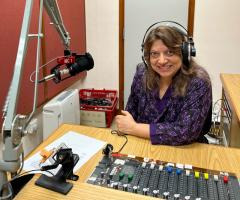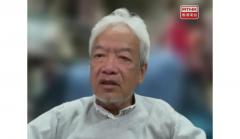簡介
Listen to #Hashtag Hong Kong every Sunday morning at 8.15
Focussing on issues affecting civil society, we'll hear from representatives of NGOs, associations, statutory bodies, and non-profit groups.
(Sundays 8.15am - 8.25am)
最新

Yiu Vor, Vice President of Hong Kong Entomological Society
Light Pollution is driving some Hong Kong species towards extinction
The Maipo Bent-winged Firefly has recently been assessed for the IUCN (International Union for Conservation of Nature) Red List of Threatened Species and listed as Endangered. An endangered species is very likely to become extinct in the near future.
Named after Mai Po, the place where it was first discovered, this firefly was described as a new species in 2011.
The rapid decline of this firefly in Fung Lok Wai suggests that the continuous and significant increase in ambient light intensity at night, caused by the coming large-scale land developments around Mai Po, may cause most or all of the sub-populations of this firefly in Hong Kong to disappear.
The Maipo Bent-winged Firefly is not the only victim. The Chenghoiyan Ototretine Firefly, a species endemic to Hong Kong, has recently been listed as Critically Endangered, indicating an extremely high risk of extinction. The population size has sharply decreased over the past 10 years, believed to be due to the erection of very bright street lamps in its highly constricted habitat. The species are also continuously threatened by light pollution from the rapidly expanding Hong Kong International Airport and Tung Chung City.
Fireflies utilize light signals for communication and finding mates. Recent studies have confirmed that Artificial Light at Night, known as ALAN, even at low intensity, could reduce the courtship and mating success of firefly species. A newly published research on America fireflies showed a significant reduction in the flashing activity of both males and females exposed to ALAN during courtship. Another study on an Europe Glow-worm firefly found that females in dark surroundings typically stopped glowing after one night, indicating that they had mated, while females in illuminated areas glowed for significantly more nights, in some cases up to 15 nights.
ALAN doesn't only affect fireflies; it also has detrimental impacts on many other insect populations, with consequences for birds and other wildlife that rely on insects along the food chain. ALAN creates fatal attraction for many nocturnal moths, beetles, and other insects, as well as spotlighting insect prey for their predators at night. Light pollution also interferes with plant phenology, disorients migrating birds and newly hatched sea turtles, and negatively impacts amphibians’ foraging and reproductive habits.
The use of artificial light at night has expanded and intensified over the past decades. Global levels of light pollution have increased by 10% every year since 2011. Recent advances in LED technology have accelerated these trends. According to data collected by HKU’s Night Sky Brightness
Monitoring Network, Hong Kong appears to have the worst light pollution on the planet – more than a thousand times brighter than the natural dark sky.
Pollution results from excessive or improper use of substances or energy. There's no difference in light pollution. Many lighting devices are unnecessarily too bright, improperly designed, installed, or used. For example, many billboards and large traffic signs are illuminated from below instead of above, causing most of the light to shine directly into the sky. This is a selfish way of installing lighting devices — sacrificing the environment for installation convenience.
It's a consensus to keep the planet healthy and beautiful for future generations. While we've spent significant political, economic, and legal resources on controlling various forms of pollution, surprisingly little has been done to regulate light pollution compared to solid, water, air, and noise pollution.
The effect of controlling light pollution is immediate. When lights are off, pollution is reduced. As citizens, there are many ways to reduce light pollution: use light only where and when needed, use the least amount of light necessary, and keep indoor lights internal by drawing curtains and lowering blinds.
However, individual efforts may not be sufficient, as many lighting devices are installed in public or commercial areas beyond individual control. The Public Lighting Design Manual prepared by the Highways Department provides guidelines for public lighting installations. But why is Hong Kong still one of the worst light-polluted cities in the world? Is the manual updated enough to address more stringent regulations on light pollution? Is its scope too narrow to cover areas not controlled by the Highways Department or owned by the commercial sector? The Environment and Ecology Bureau implements the “Charter on External Lighting” aimed at encouraging owners and responsible parties of external lighting installations to switch off lighting installations for decorative, promotional or advertising purposes which affect the outdoor environment during the preset time. As a Charter without Legal bindings, its effectiveness is questionable. Introduced in 2016, the charter has garnered signatures from less than 5,000 organizations to date. In contrast, countries like France, Slovenia, Croatia, the Czech Republic, the UK, and New York have implemented laws aimed at curbing light pollution. Considering Hong Kong's status as an advanced city, there is a pressing need for more proactive measures to combat light pollution.
This morning I’d like to dedicate this song “A Sky Full of Stars” by Coldplay to all of you listening.
Thank You
重溫

Katie Wong, Chief Officer (Elderly Service) The Hong Kong Council of Social Service
As the population ages, more people find caring for their elderly loved ones falling on their shoulders. While the population of Hong Kong increased only by 5% between 2011 and 2021, the population of centenarians, people aged 100 or more, increased by more than 6 folds.
In light of the rapid increase in the population of adults of advanced age, say nonagenarians and centenarians, in collaboration with The University of Hong Kong and Hong Kong Shue Yan University, The Hong Kong Council of Social Service recently conducted the second round of the Hong Kong Centenarian Study (with the first round taking place in 2011) with 151 families and found that most caregivers of centenarians are their children, with many of them being between 65-74 years old (43%).
This phenomenon of “the elderly caring for even older seniors” is common in Hong Kong. It poses significant challenges, including physical fatigue, emotional stress, social isolation, and financial burden, adversely impacting caregivers’ health and well-being.
The biggest challenge faced by elderly caregivers is physical and mental fatigue. Caring for a loved one requires a lot of strength and energy, which can be even more taxing for elderly caregivers with health issues. They may have to frequently lift or support a frail loved one, provide assistance in daily living, and perform other tasks that can strain their bodies continually.
Emotional stress is another challenge, particularly when caring involves complex or arduous needs. For example, tending to a loved one with dementia or other cognitive impairments requires infinite patience and constant attention, which can be frustrating and overwhelming. Many caregivers wish to see their older loved ones through and are motivated to provide as much care to their older relatives as possible. Despite such high motivation to care, their strains may elevate to a point where their mental and physical health is compromised, which is when nursing home placements are considered.
Caregivers may also feel isolated and burnt out, as they often have to sacrifice socialising with friends and family or their interests. This can spiral into depression and anxiety, further exacerbating their struggles.
The financial burden is another challenge that elderly caregivers may grapple with, especially those who are retired and living on a fixed income. In other words, their financial resources, whether from their own children or governmental subsidies, are often shared with their older loved ones. The study mentioned above showed that 83.2% of caregivers had a monthly income below $30,000, and 70.5% of respondents earned below the poverty line of $20,000 for a 4-person household (CSD, 2020). 48.3% of caregivers expressed financial pressure.
So, what can be done to aid elderly caregivers facing these problems? Here are a few suggestions:
1) Seeking out community resources, including respite care, support groups, and counselling services. Elderly caregivers should also reach out to family and friends for help, as small gestures can make a big difference.
2) It is also essential for caregivers to prioritise their health and well-being by taking time for themselves, pursuing hobbies and interests, or getting mental health support when needed. Caregivers who look after themselves are better equipped to watch over their loved ones in the long run.
3) Sometimes, it may be necessary to hire a professional caregiver to assist with the needs of a loved one. With the advance in technology, some products help, such as fall prevention equipment and health-monitoring smart devices. Caregiver subsidies or financial subsidies for using Gerontechnology in the community would help.
Taking care of an elderly loved one can be arduous and emotionally draining, particularly for caregivers themselves, seniors. By seeking out available resources, asking for help from family and friends, being mindful of self-care, and appraising professional assistance, elderly caregivers can get the support they need to navigate the challenges and provide the best care possible for their loved ones.
And now I have a song I'd like to dedicate to all of you listening. My song is: You’ve Got a Friend by Carole King

















